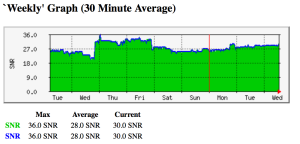The E is for Easy
February 5, 2016 5 Comments
I’ve been struggling to put into words just how straightforward configuring the ePMP 1000 from Cambium Networks is. While that may sound like something completely boring to write about, I assure you, once you’ve tried to administer or even out of the box configure Point to Point links from the likes of most anyone else, you really come to appreciate the simplicity and readiness of the out of the box experience that Cambium has so clearly focused on. The ePMP 1000 unit is part of the broader Cambium Backhaul and Access portfolio and can be used in a variety of roles depending on your network layout and your overall throughput and performance needs. Architecture and design topics aside, the biggest challenge I had with the evaluation units I received was making sure they had the latest firmware on them. Starting there (and that was even really straightforward), I applied the latest firmware to both units then cleared their configs. I took the remote side (Subscriber Module) and put it in the other room with local power applied to it. I then powered up the close unit and changed it to ‘Access Point’ then rebooted it. From this point forward, all of the other settings were optional including changing my hostnames, IP addresses, NTP servers, SNMP strings, etc. The point being, when they say ‘Quick Start’, they mean quick!

The SM (Subscriber Module) joined the AP (Access Point) as close to ‘automatically’ as I could envision a product being. Of course, just because they came up rapidly doesn’t mean they’re short on features or configurable options – there’s no need to stick to the default security settings, management settings, or any of the radio specific performance settings – all seem to be highly customizable and well worth exploring.

Easy to understand SM link info
One other ‘nice feature’ is of course the SNMP polling you’d expect from a good piece of network gear. While it may seem like a simple feature, the ability to setup MRTG at point it at a radio interface for downlink SNR was very easy to do. Here is the snippet I used from MRTG after changing my SNMP community strings:
Target[ePMPdownSNR]: 1.3.6.1.4.1.17713.21.1.2.18.0&1.3.6.1.4.1.17713.21.1.2.18.0:snmp_string@192.168.3.62:::::2
Title[ePMPdownSNR]: ePMP1000 downlink SNR
MaxBytes[ePMPdownSNR]: 100
Options[ePMPdownSNR]: gauge,growright,nopercent
PageTop[ePMPdownSNR]: <H1>ePMP1000 downlink SNR</H1>
ShortLegend[ePMPdownSNR]: SNR
YLegend[ePMPdownSNR]: SNR
LegendI[ePMPdownSNR]: SNR
LegendO[ePMPdownSNR]: SNR
and here’s what the resultant charts look like:


All in all, if you’re in the market for a new point to point solution, I’d advocate you go check out the ePMP and other Cambium products. They’re priced right and have the features that make sense.
Full disclosure: as a Wireless Field Day 8 delagate, Cambium Networks provided me a pair of ePMP 1000 units for personal use with no obligation to write about them. The above article is done at no cost or commitment to either the Tech Field Day organization or Cambium Networks.
As requested, here are some pictures of the gear itself.




